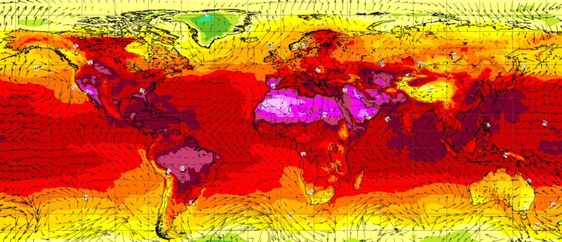
This is equivalent to the total carbon footprint of tens or hundreds of people in many countries of the world. Most people in the world do not take flights. There is no reliable global figure but often cited estimates suggest that more than 80% of the global population has never flown.1Private jets are 5 to 14 times more polluting than commercial planes per passenger and 50 times more polluting than trains.
— Paul Dawson 📚 (@PaulEDawson) August 15, 2023
50% of all aviation emissions were caused by 1% of the world’s population. https://t.co/ScyGCDDyWK pic.twitter.com/ti92daTTaF
Aviation accounts for around 2.5% of global carbon dioxide (CO2) emissions. But if you are someone who does fly, air travel will make up a much larger share of your carbon footprint.
The first and most straightforward comparison is to look at emissions from domestic aviation – that is, flights that depart and arrive in the same country.
We see large differences in emissions from domestic flights across the world. In the United States, the average person emits around 386 kilograms of CO2 each year from internal flights. This is followed by Australia (267 kg); Norway (209 kg); New Zealand (174 kg); and Canada (168 kg). Compare this with countries at the bottom of the table – many across Africa, Asia, and Eastern Europe, emitting less than one kilogram per person – just 0.8 kilograms, or 0.14 kilograms in Rwanda. For very small countries where there are no internal commercial flights, domestic emissions are, of course, zero.
Per capita emissions from domestic and international flights
Let’s combine per capita emissions from domestic and international travel to compare the total footprint from flying. This is shown in the interactive map [we’ve taken the adjusted international figures – you can find the combined figures without tourism adjustment here].
The global average emissions from aviation were 103 kilograms.
The inequality in emissions across the world becomes clear when this is broken down by country.
At the top of the table lies the United Arab Emirates – each person emits nearly two tonnes – 1950 kg – of CO2 from flying yearly. That’s 200 times the global average. This was followed by Singapore (1173 kilograms); Iceland (1070 kg); Finland (1000 kg); Australia (878 kg); Switzerland (761 kg); Sweden (746 kg); Germany (712 kg), and Norway (634 kg).
To put this into perspective: a return flight (in economy class) from London to Dubai/United Arab Emirates would emit around one tonne of CO2.6, So the two-tonne average for the UAE is equivalent to around two return trips to London.
In many countries, most people do not fly at all. The average Indian emits just 18 kilograms from aviation – this is much, much less than even a short-haul flight which confirms that most did not take a flight.
We can compare just the top countries’ aviation emissions to citizens’ total carbon footprint elsewhere.
The average UAE citizen emits 1950 kilograms of CO2 from flying. This is the same as the total CO2 footprint of the average Indian (including everything from electricity to road transport, heating, and industry). Or, to take a more extreme example, 200 times the total footprint of the average Nigerien, Ugandan, or Ethiopian, which have per capita emissions of around 100 kilograms.
This again emphasizes the large difference between the global average and the individual emissions of people who fly. Aviation contributes a few percent of total CO2 emissions each year – this is not insignificant, but far from being the largest sector to tackle. Yet from the perspective of the individual, flying is often one of the largest chunks of our carbon footprint. The average rich person emits tonnes of CO2 from flying each year – this is equivalent to the total carbon footprint of tens or hundreds of people in many countries of the world.




Comments are closed.